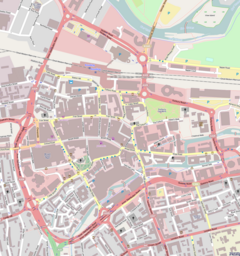Reading Town Hall
| Reading Town Hall | |
|---|---|
 |
|
|
Location within Reading Town Centre
|
|
| General information | |
| Type | Town hall |
| Architectural style | Italianate |
| Location | Reading, Berkshire, UK |
| Coordinates | 51°27′25″N 0°58′12″W / 51.45695°N 0.97005°WCoordinates: 51°27′25″N 0°58′12″W / 51.45695°N 0.97005°W |
| Construction started | 1786 |
| Completed | 1897 |
| Design and construction | |
| Architect | Alfred Waterhouse |
Reading Town Hall is the town hall for the town of Reading, in the English county of Berkshire. The town hall was built in several phases between 1786 and 1897, although the principal facade was designed by Alfred Waterhouse in 1875. Situated close to the site of Reading Abbey, it is adjoined to the north by the Hospitium of St John and to the south by St Laurence's Church.
No longer the home of the town's administration, the Town Hall now houses the Museum of Reading, a large concert hall, several smaller halls and conference rooms, and a public cafe. It is a listed building, with the block designed by Alfred Waterhouse being listed grade II*, whilst other parts of the building are listed grade II.
The first recorded town or guild hall for Reading was known as the Yield Hall and is known to have been situated beside the River Kennet near the current Yield Hall Lane. However by the middle of the 16th century this had proved too small, and the spoils of the dissolution of the monasteries were to provide both of the town's next two halls. Initially, in 1543, the town was granted part of the former friary that was later to become Greyfriars Church.
However Greyfriars did not prove a successful town hall, and some twenty years later the council created a new town hall by inserting an upper floor into the former refectory of the Hospitium of St John, Reading Abbey's hospitium. The lower floor of this building continued to be used by Reading School, as it had been since 1486. For the next 200 years, the old monastic building continued to serve as Reading's town hall, but by the 18th century it was suffering from structural weakness.
...
Wikipedia

